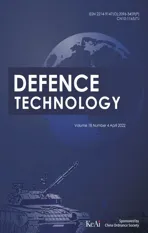A novel feature extraction method for ship-radiated noise
2022-04-19HongYangLuluLiGuohuiLiQianruGuan
Hong Yang, Lu-lu Li, Guo-hui Li, Qian-ru Guan
School of Electronic Engineering, Xi’an University of Posts and Telecommunications, Xi’an, Shaanxi, 710121, China
Keywords:Complete ensemble empirical mode decomposition with adaptive noise Ship-radiated noise Feature extraction Classification and recognition
ABSTRACT To improve the feature extraction of ship-radiated noise in a complex ocean environment,a novel feature extraction method for ship-radiated noise based on complete ensemble empirical mode decomposition with adaptive selective noise (CEEMDASN) and refined composite multiscale fluctuation-based dispersion entropy (RCMFDE) is proposed. CEEMDASN is proposed in this paper which takes into account the high frequency intermittent components when decomposing the signal. In addition, RCMFDE is also proposed in this paper which refines the preprocessing process of the original signal based on composite multi-scale theory.Firstly,the original signal is decomposed into several intrinsic mode functions(IMFs)by CEEMDASN. Energy distribution ratio (EDR) and average energy distribution ratio (AEDR) of all IMF components are calculated.Then,the IMF with the minimum difference between EDR and AEDR(MEDR)is selected as characteristic IMF. The RCMFDE of characteristic IMF is estimated as the feature vectors of ship-radiated noise. Finally, these feature vectors are sent to self-organizing map (SOM) for classifying and identifying. The proposed method is applied to the feature extraction of ship-radiated noise. The result shows its effectiveness and universality.
1. Introduction
In the early 1950s, underwater acoustic signal processing technology is increasingly concerned by humans. In particular, it is widely used in military technology such as submarine operations and anti-submarine operations, mine operations and anti-mine operations [1,2]. In the course of the ship’s driving, due to the vibration of the hull power system and the rotation of the propeller,a noise is emitted into the surrounding sea area,which is called shipradiated noise. Ship-radiated noise is a nonlinear, non-stationary signal, which contains a lot of ship characteristics [3,4]. It also contains a number of high frequency intermittent components[5].With the further research and development of the marine environment, the effective ship-radiated noise feature extraction technology has very important significance in the classification and recognition of underwater target signals. Traditional ship-radiated noise feature extraction methods mainly include:spectral features[6], high-order statistics [7], short-time Fourier transform (STFT)[8], wavelet transform [9], Dopplerlet transform [10], Wigner-Vill distribution [11], chaos theory [12], wave structure feature [13],recursive analysis [14], zero crossing feature [15], autocorrelation feature [16], etc. At present, three extraction methods are mainly formed as follows: 1) Research the characteristics of the signal in the time domain and frequency domain directly,construct a feature vector to classify the ship radiation noise[17,18].2)Decompose the signal first, and then calculate indicators such as high and low frequency energy difference,instantaneous energy change range or energy entropy according to some intrinsic mode functions(IMFs),and use the above indicators as characteristic parameters[19-21].3) After decomposing the signal, select the most representative IMF, and use the center frequency, energy density or Shannon entropy of the IMF as the characteristic parameters[22,23].Relatively speaking, the feature extraction method based on empirical mode decomposition and entropy is more effective. But if the amount of data of the ship target signal is large, the amount of entropy calculation will be greater, the speed will be slower, and the accuracy and stability will be reduced.In view of some shortcomings of the above methods,it is necessary to combine the EMD method with better decomposition effect and entropy with better performance, and apply it to ship-radiated noise processing.
Empirical mode decomposition (EMD) proposed by Huang[24,25] has been widely used in underwater acoustic signal processing. Although it can better reflect the physical characteristics, mode mixing easily appears in the decomposition result of EMD [26-28], which can lead to confusing time-frequency and unsatisfactory decomposition results. In order to alleviate these problems, many improved methods have been proposed such as ensemble empirical mode decomposition (EEMD) [29-31], complementary ensemble empirical mode decomposition (CEEMD)[32-34], complete ensemble empirical mode decomposition with adaptive noise (CEEMDAN) [35-37]. Although CEEMDAN has the best decomposition effect,it has some problems such as the second type of mode mixing phenomenon, higher time consuming and larger residual errors. Aiming at these problems, complete ensemble empirical mode decomposition with adaptive selective noise (CEEMDASN) is proposed in this paper.
In recent years, the entropy proposed by Shannon [38] is a common tool for estimating the signal’s complexity and uncertainty.Sample entropy(SampEn)[39,40],energy entropy(EE)[41],permutation entropy(PE)[42,43],multi-scale permutation entropy(MPE) [44,45] and so forth have been proposed. The accuracy and stability of these entropies are not high.Moreover,the relationship between amplitudes is not considered.The dispersion entropy(DE)[46] proposed by Rostaghi is widely used in signal processing[47,48].However,DE has certain limitations for nonlinear and nonstationary signals because it does not take into account the influence of signal fluctuation on the mapping [49,50]. Therefore, the fluctuation-based dispersion entropy(FDE)[51]has been proposed.FDE improves computing speed and recognition rate by comparing with DE [52,53]. Inspiring by multiscale entropy [54,55] and composite multiscale [56], we have proposed refined composite multiscale fluctuation-based dispersion entropy (RCMFDE). Its key point is to further refine the preprocessing of original data.
In recent years,there are two methods for feature extraction of ship radiated noise signal by CEEMDAN. One is to combine CEEMDAN with energy entropy and energy difference to obtain the feature vector,and the other is to combine CEEMDAN with Duffing chaotic oscillator and weighted-permutation entropy to extract the line spectrum frequency of the signal[57,58].Although they have a higher recognition rate than traditional method, they also have many problems. For example, the algorithm CEEMDAN has the disadvantages of long time consuming and large errors; although energy entropy can accurately describe the energy distribution of the signal,but it is less accurate in estimating the complexity of the signal;although weighted permutation entropy solves the problem that permutation entropy cannot fully consider the symbol mode,it is insensitive to changes in time series and has lower efficiency compared with dispersion entropy.
In view of the above analysis, CEEMDASN and RCMFDE are proposed respectively.A novel feature extraction method based on CEEMDASN and RCMFDE is proposed and applied to the feature extraction of ship-radiated noise. For the convenience of reading,the nomenclature used in this paper is shown in Appendix A.
2. Basic theory
2.1. Basic theory of CEEMDASN
2.1.1. CEEMDAN


The decomposition process of CEEMDAN is complete.CEEMDAN not only can decompose the original signal more completely, but also is more clearly than EMD in terms of decomposition effect[62].
2.1.2. CEEMDASN
If the signal contains high frequency intermittent components,EMD may lead to the first type of mode mixing phenomenon. The signal components with different time scales appear in the same modes. In order to solve the problem, the effect of CEEMDAN is better. However, the second type of mode mixing phenomenon may occur in the decomposition process of CEEMDAN owing to the randomness of the increased adaptive white noise. It is the signal components on the same time scale are decomposed into different modes. In addition, CEEMDAN algorithm has the disadvantage of higher time consuming and larger residual errors.
In view of the above analysis, CEEMDASN algorithm takes into account high frequency intermittent components when decomposing signals. The key technique is to check the high frequency intermittent components from the beginning and ending of time series by detecting the variance of the time interval between extreme values.Because the interval between the extreme values of the intermittent components is not stable, but has a jump characteristic. The specific steps of CEEMDASN are summarized as follows:
Step 1:Define a test function Var(t)which is the variance of the time interval between extreme values. If there is an intermittent component in x(t), Var(t) is recorded as 1. Otherwise, Var(t) is recorded as 0.
Step 2:The following decomposition is performed according to the two cases of Var(t).
(I) If Var(t) is 1, a pair of adaptive white noise sequences are added in x(t). The original sequence at this time can be expressed as
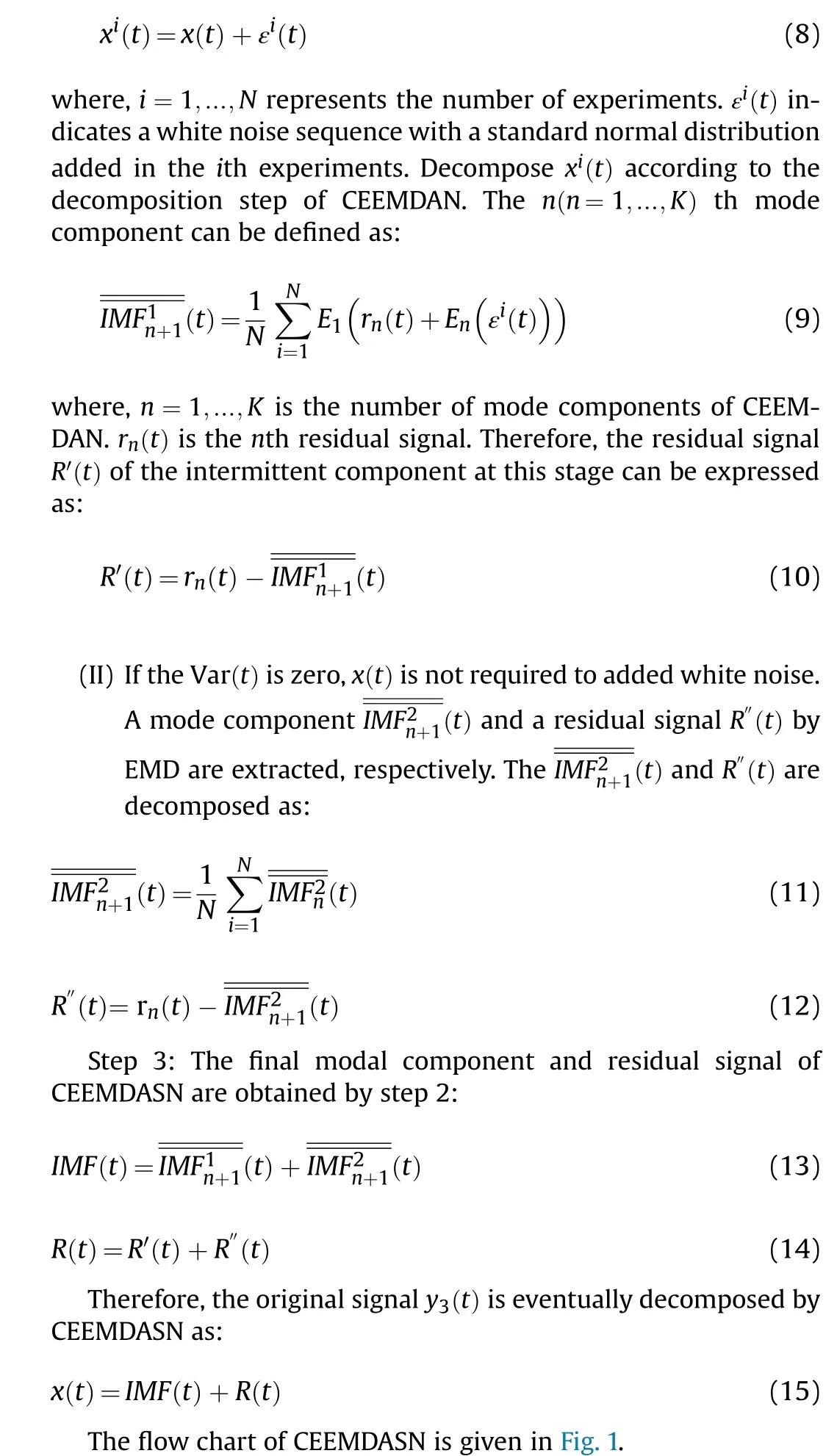
2.1.3. The analog signal analysis based on CEEMDASN
To verify the superiority of CEEMDASN,EMD,EEMD,CEEMDAN,and CEEMDASN are used to decompose the analog signal. It is expressed as:

Fig. 2 shows that the analog signals are decomposed into different number IMFs.Although the amount of IMF obtained from EMD is the least,there is an obvious aliasing phenomenon at IMF3 and IMF4.In addition,the mode mixing phenomenon still exists in Fig. 2(b) and (c). As can be observed from Fig. 2(d), the decomposition results of CEEMDASN are more clearly. To illustrate the advantages of CEEMDASN in reducing residual error,I is the ensemble average number of times, which is taken as 50,100, 200 and 300.Their residual errors are shown in Fig. 3.
It can be seen from Fig. 3 that the residual errors of the four decomposition algorithms show a decreasing trend. EMD has the largest residual error and CEEMDASN is the smallest.The proposed decomposition algorithm can effectively reduce the residual error.
To further verify the superiority of CEEMDASN, these parameters of EMD, EEMD, CEEMDAN and CEEMDASN are evaluated such as consuming time (CT), index of orthogonality (IO) and similarity index (SI). When the IO is zero, the IMF component is completely orthogonal. Conversely, the IO is larger; the mode mixing phenomenon between the two IMFs is more severe.The definition of IO is as follows [63]:
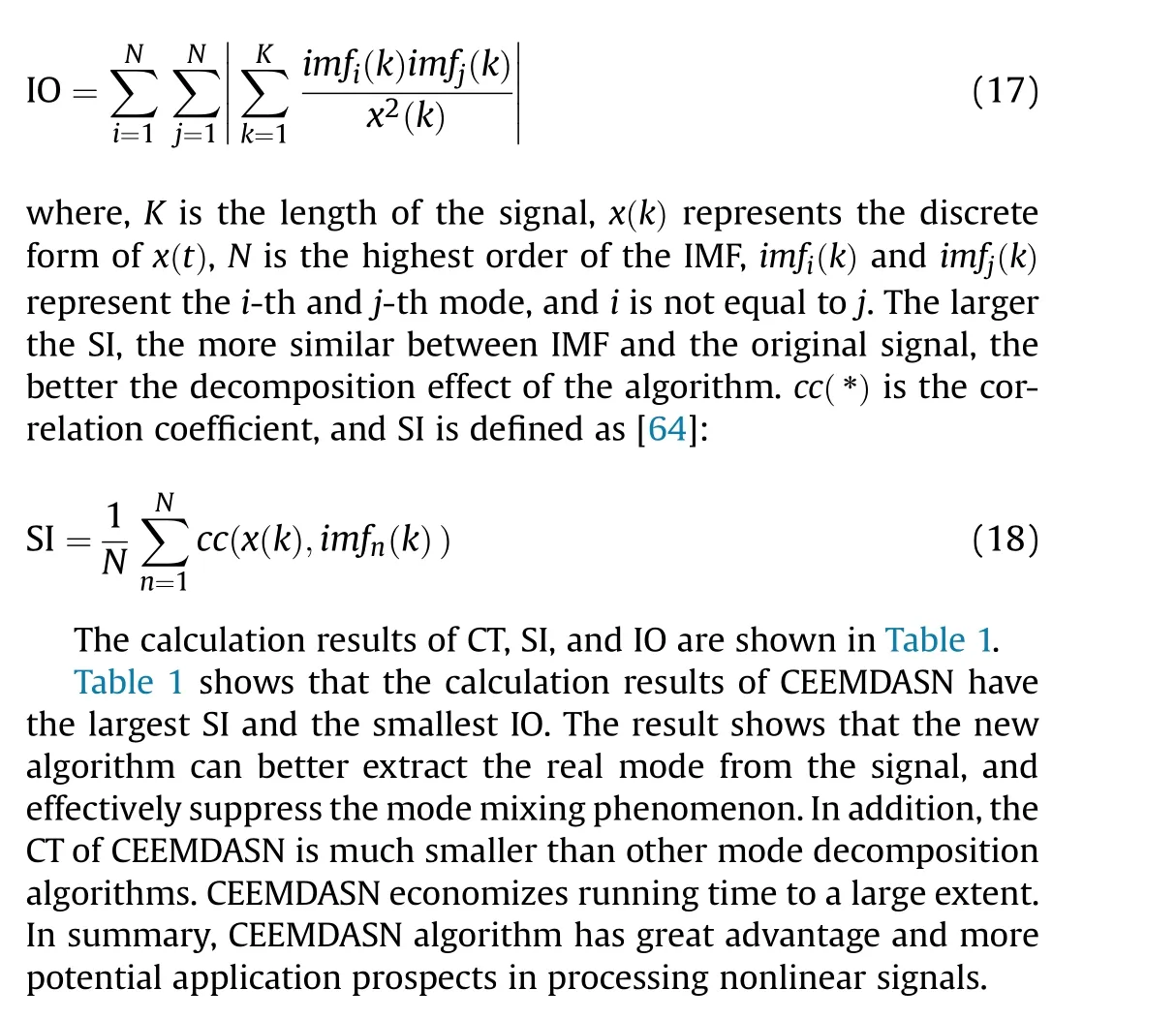
2.2. Basic theory of RCMFDE
2.2.1. MFDE algorithm
The difference between DE algorithm and PE algorithm is that the former uses the log-sigmoid mapping to detect the abnormal value of the signal. In addition, FDE computes only the normal cumulative distribution function (NCDF) mapping of the first time scale.The basic theories and specific steps of DE and FDE have been respectively described in Refs. [65,66]. MFDE is mainly based on FDE for multiscale research on time series. Its specific steps are as follows:
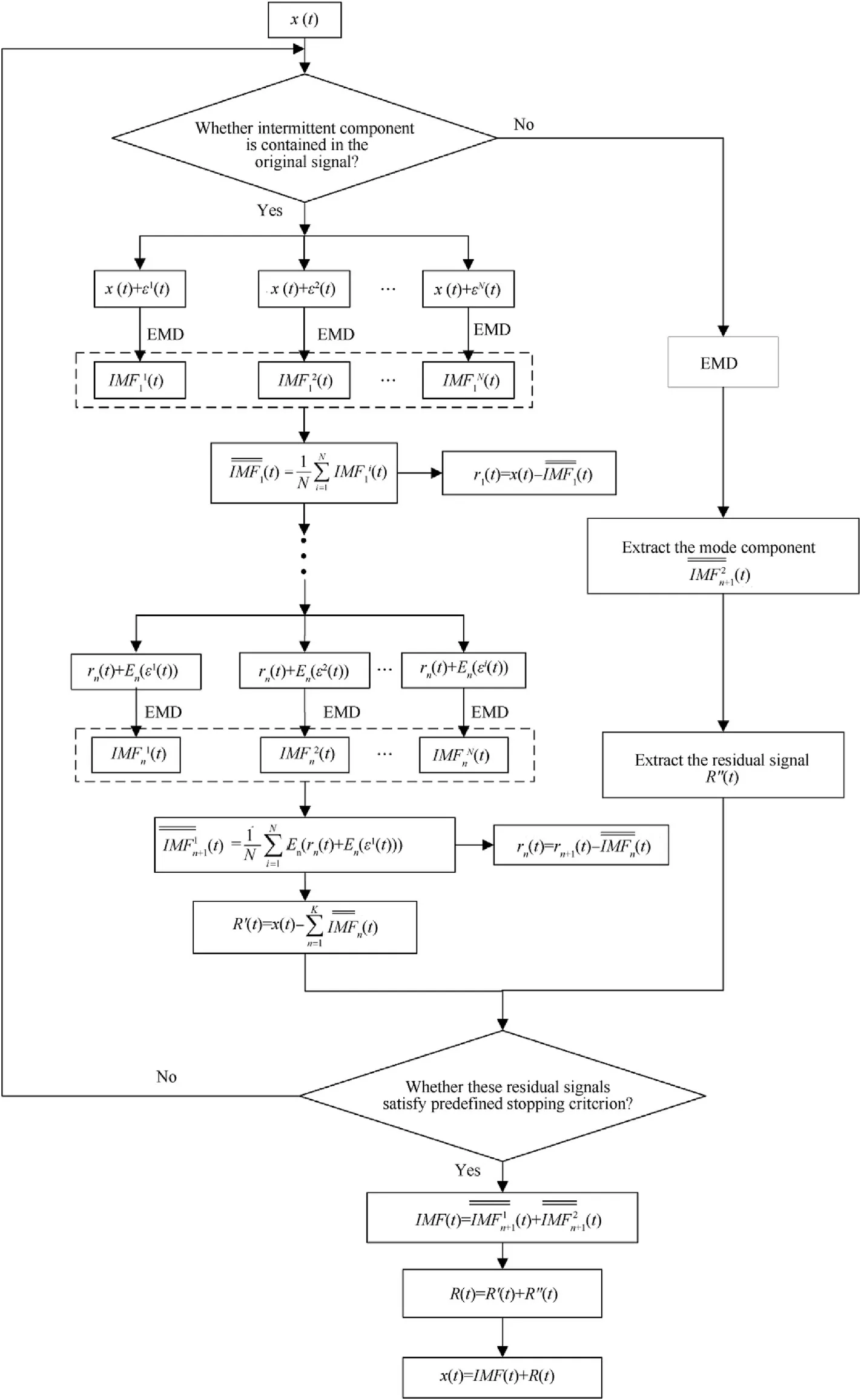
Fig.1. The flow chart of CEEMDASN.
Step 1:The original time series is represented as x = x(j =1,2,…,N), the signal with the length of N is divided into short time series of equal length τ. τ is the scale factor, and the k-th coarsegrained time series is defined as:

Step 2: Map x=x(j=1,2,…,N) to class c, and mark them in order from 1 to c. Map x to y={y,y,···,y}by NCDF.

where,σ and μ represent the standard deviation(SD)and average.
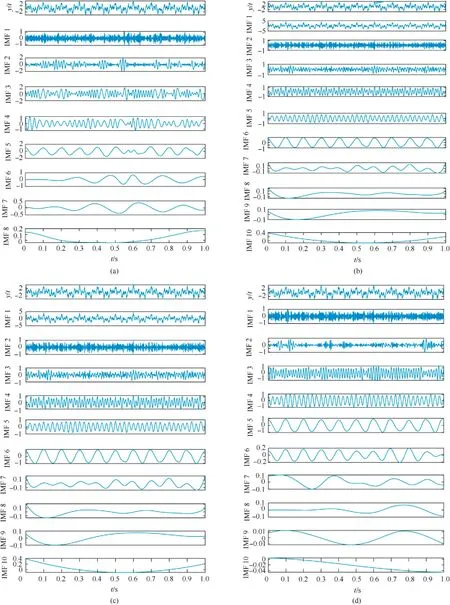
Fig. 2. The decomposition results of (a) EMD; (b) EEMD; (c) CEEMDAN; (d) CEEMDASN.
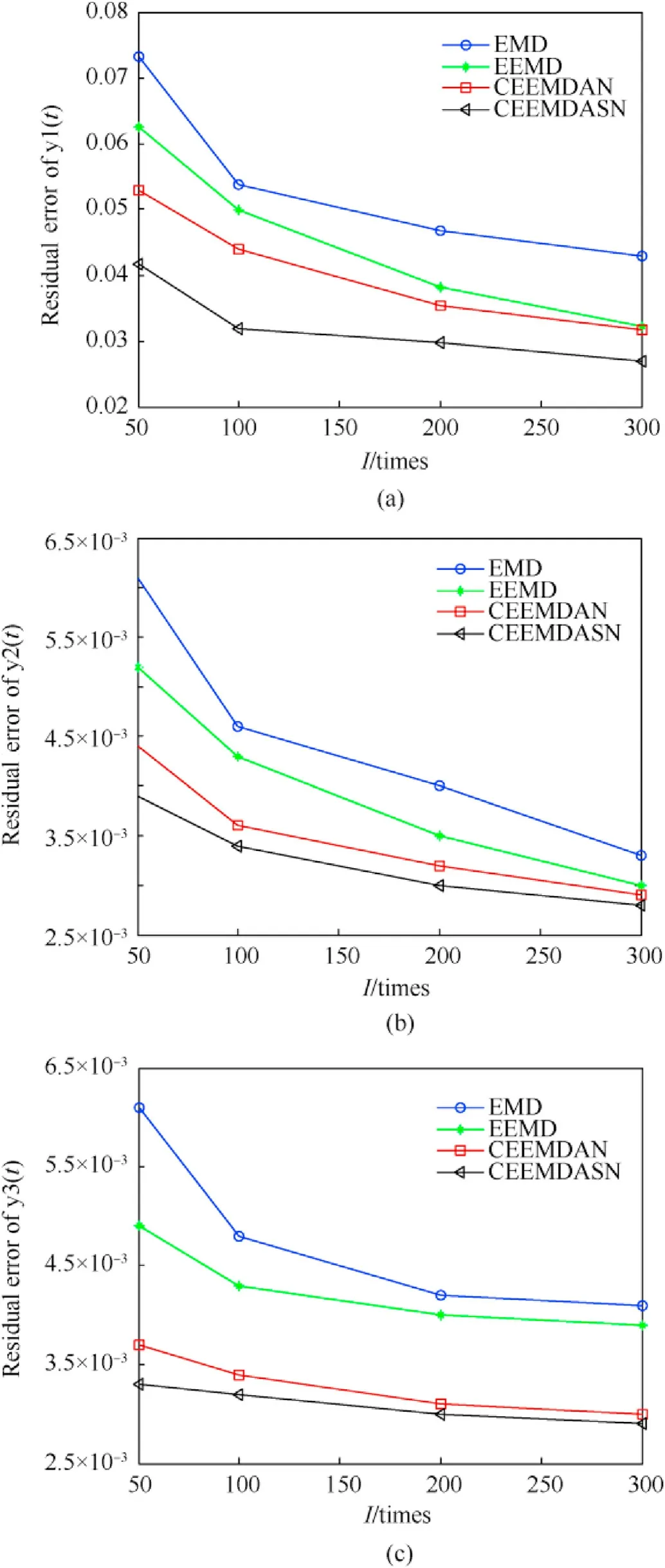
Fig. 3. Residual error when recovering (a) y1(t); (b)y2(t); (c)y3(t).


Table 1 The calculation results of CT, SI and IO.
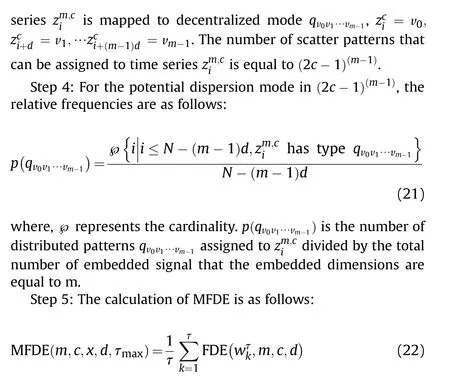
The larger the value of MFDE is, the higher the irregularity is.Otherwise, the irregularity is lower. As can be seen from the calculation process of MFDE,when all the scatter patterns have the same probability, the degree of irregularity of data is highest.Conversely, when p(q) has only one value or predictable data, the MFDE is the smallest, such as the determined periodic signals [67].
2.2.2. RCMFDE algorithm
The multiscale process of MFDE is the same as MPE and MSE,and they are equally divided and averaged.Although MFDE is faster than MSE, it does not take into account the existence of a relationship between the segmented data, which is likely to loss the statistical information and has a certain deviation from the initial position. Therefore, the preprocessing process of the original data by RCMFDE should be further refined on the basis of MFDE.When calculating the RCMFDE with a scale factor of τ,the original data is successively divided into some non-overlapping segments with a length of τ according to the initial point [1,τ]. And the average of these segments is calculated. The τ coarse-grained time series can be obtained by arranging these average values in order as one coarse-grained time series. The specific steps of RCMFDE are as follows:

Step 2: The RCMFDE is defined as follows:
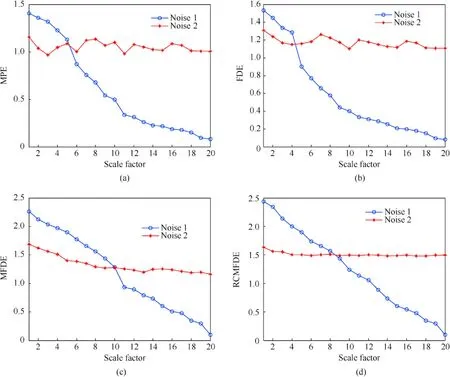
Fig. 4. The simulation results of Noise1 and Noise2 by (a) MPE; (b) FDE; (c) MFDE; (d) RCMFDE.
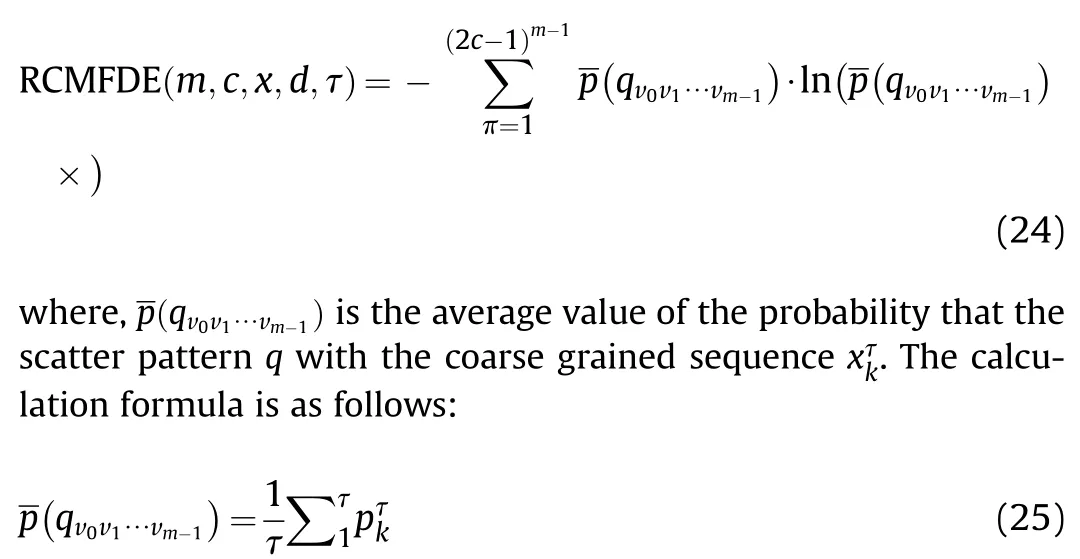
As can be seen from the calculation process of RCMFDE, the RCMFDE can reduce the impact of the initial point position on entropy value by averaging the multiple initial point positions.Therefore,the refined processing of original signals can reduce the loss of some statistical information.So the calculation error caused by MFDE can be greatly reduced. The parameters of the RCMFDE include embedding dimension m, categories number c, time delay d and maximum scale factor τ. The value of the embedded dimension should not be too large or too small, and then the m is set to 3 in this paper.When c is greater than 1,the case of only one fluctuation dispersion mode can be avoided. The approximate range is 2 ≤c ≤9, in this paper, c is set to 3. For time delay d, it cannot be greater than 1. Otherwise it can lead to a mode mixing phenomenon. In this paper, d is set to 1.
2.2.3. Simulation signal analysis based on RCMFDE
To verify the correlation characteristics of RCMFDE in processing nonlinear signals,two types of noise signals are analyzed.The mean standard deviation of Gaussian white noise(Noise1)and 1/f noise(Noise2)are calculated.Noise1 and Noise2 are composed of 20 sets of noise with a length of 3000, and the scale is 20. The simulation results of Noise1 and Noise2 by MPE,FDE,MFDE,and RCMFDE are shown in Fig. 4.
It can be seen from Fig.4 that there is almost no difference in the overall trend of the four types of entropy.Noise1 has larger entropy value on low scale, and the entropy of Gaussian white noise monotonously decreases with the increase of scale. Because the curve change of Noise2 is not obvious, the internal structure of Noise2 is more complex, and the main information of 1/f is reflected on a large scale. In addition, the curve of RCMFDE is fairly smooth and stable than that of MPE, FDE and MFDE.
2.3. The basic theory of self-organizing map
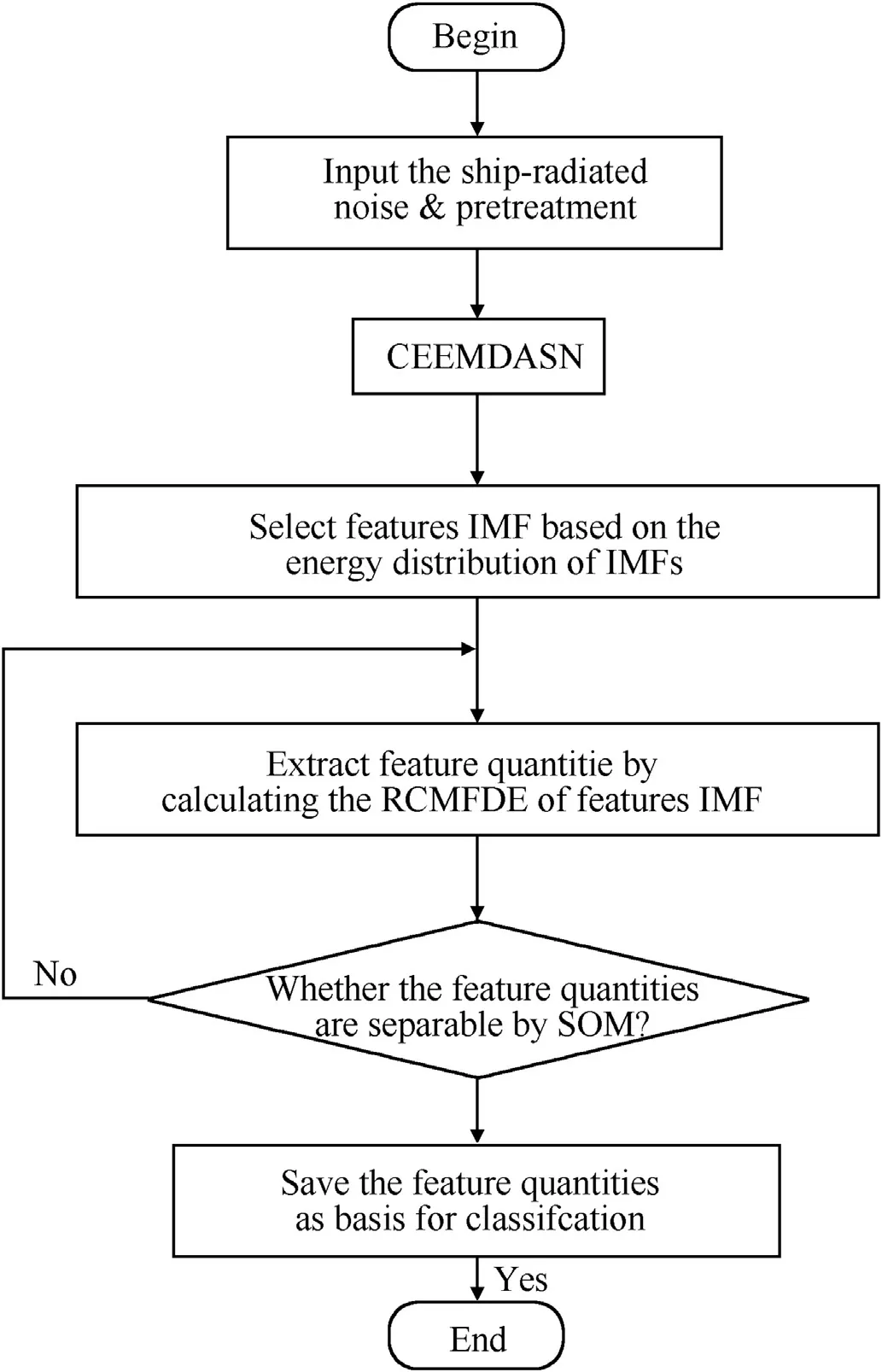
Fig. 5. The flow chart of the proposed feature extraction method.
The self-organizing map(SOM)is a machine-learning technique of the artificial neural network family.Because it has relatively high flexibility and adaptability, it has been exploited to classify and identify different kinds of signals [68-70]. In order to distinguish different types of signals more effectively, feature vectors are sent to SOM for classifying and identifying.
3. The proposed method
In the complex marine environment,the generation mechanism of the target radiated noise signal is different for different types of targets.It can lead to a large difference in acoustic signal structure.Because the sources of the signals are almost the same, their distribution is basically no difference for the same type of target.If the processing method of frequency domain natural division of the target radiation noise can be found, extracting the feature parameters corresponding to the available frequency bands is relatively easy to solve. Therefore, this paper proposes a novel feature extraction method of ship-radiated noise under complex ocean environment based on CEEMDASN, MEDR and RCMFDE, named CEEMDASN-MEDR-RCMFDE. Its main steps are as follows:
Step 1: A series of IMF components can be obtained from decomposing three types of ship-radiated noise signals by CEEMDASN.
Step 2: Calculate the energy distribution ratio of IMF components and average energy distribution ratio.
Step 3: The IMF with the minimum difference between energy distribution ratio and average energy distribution ratio is selected as characteristic IMF.
Step 4: The 50 data sets with data length of 500 are randomly selected from the IMF obtained by step 3. And then, estimate the RCMFDE of the 50 sets of data as feature vectors.
Step 5:The feature vectors obtained from step 4 are sent to the SOM for observing the classification result. A classification stop criterion is set in advance by calculating the classification error rate.In this paper,if the error rate is less than or equal to 3%,the current feature vectors are saved.Otherwise,return to step 4 to execute the algorithm. Its flow chart is shown in Fig. 5.
4. Feature extraction of ship-radiated noise based on CEEMDASN and RCMFDE
4.1. The decomposition of ship-radiated noise based on CEEMDASN
Three different types of ship-radiated noise are obtained from the official website of the national park service (http://www.nps.gov/glba/learn/nature/soundclips.htm). For convenience, the ferry signal is recorded as Ship-I, the cruise ship signal is recorded as Ship-II, the freighter signal is recorded as Ship-III. All ship target signals have 30 sample data whose length is 5000 points. Its sampling frequency is 44.1 kHz. The time domain waveforms of Ship-I, Ship-II and Ship-III are shown in Fig. 6(a), (c) and (e). The decomposition results of Ship-I,Ship-II and Ship-III by CEEMDASN are shown in Fig. 6(b), (d) and (f).
Fig. 6(b), (d) and (f) show that Ship-I, Ship-II and Ship-III are decomposed into different IMF components by CEEMDASN. To further verify the superiority of CEEMDASN algorithm,EMD,EEMD and CEEMDAN are also applied to ship-radiated noise. The calculation results of CT, SI, and IO are shown in Table 2.
Comparing the evaluation indicators of Table 2, it is found that CEEMDASN has the characteristics of minimum IO and maximum SI, which indicate that the algorithm can better extract the real mode from the signal and effectively suppress the mode mixing.In addition, CEEMDASN takes much less time than other EMD algorithms.Therefore,CEEMDASN is conducive to processing nonlinear,non-stationary signal.
4.2. Feature extraction of ship-radiated noise
The key technology of feature extraction under complex ocean environment is to obtain more representative target feature parameters. To illustrate the identification and classification of RCMFDE as the feature parameters of ship-radiated noise, 30 samples are selected. The distribution of MPE, FDE, MFDE and RCMFDE are shown in Fig. 7.
Because the complex ocean background noise has strong interference,it will greatly affect the feature extraction of ship-radiated noise.Fig.7(a)shows that the MPE distributions of the three types of ship-radiated noise are basically between 1.44 and 1.6,which are completely mixed together, and the entropy value fluctuates greatly, which makes it difficult to distinguish them. The characteristic parameters of Ship-I and Ship-III in Fig.7(b)are basically at the same level, the distinguishing effect is not ideal, and the entropy value of Ship-II fluctuates greatly. Although the degree of entropy confusion in Fig.7(c)is lower than that of MPE and FDE,it is also difficult to distinguish. Fig. 7(d) shows that although the RCMFDE distribution curve is not very stable, the resolution of RCMFDE is better than that of MFDE to some extent. The characteristic IMF is shown in Table 3.
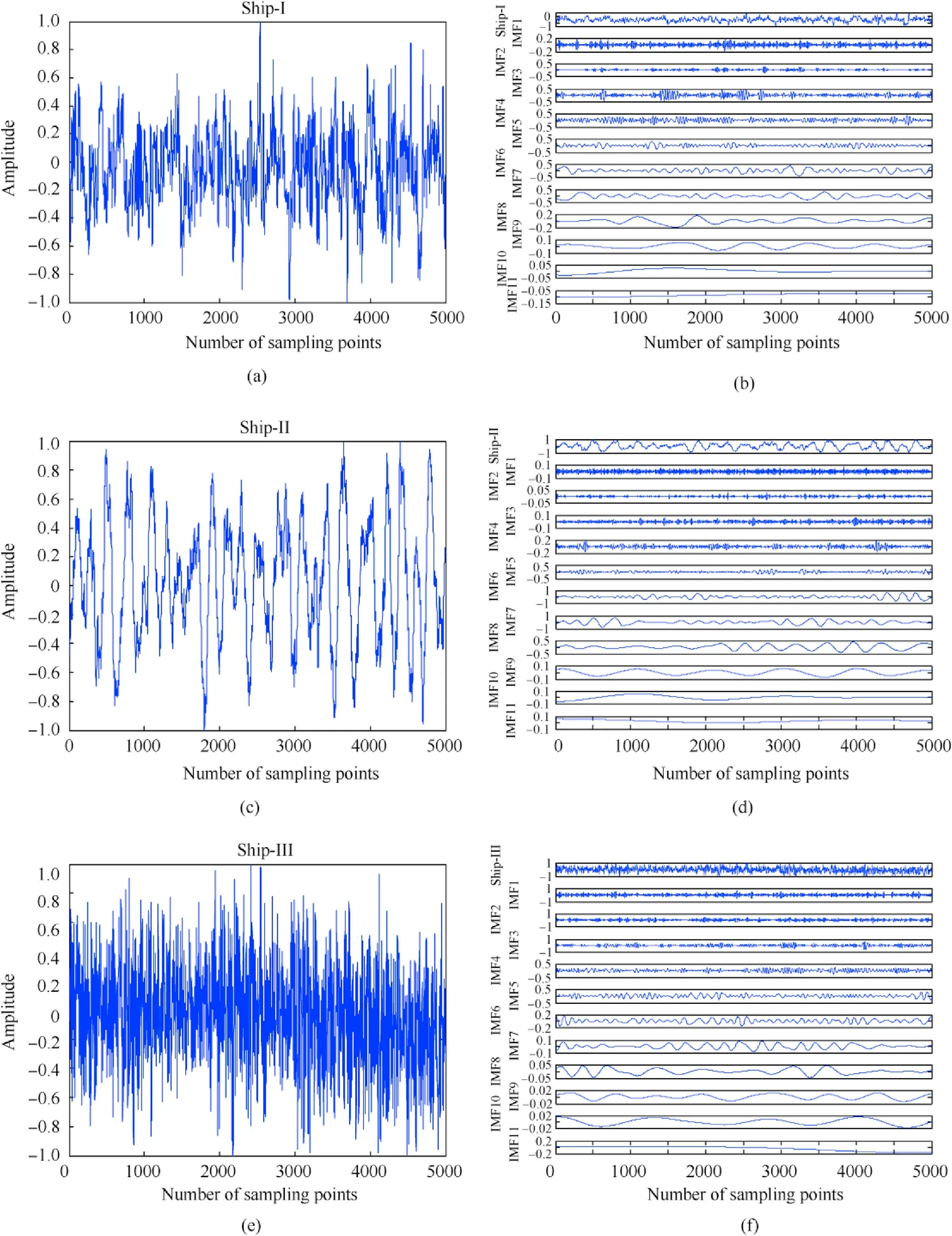
Fig. 6. Time-domain waveform and decomposition results of ship-radiated noise. (a), (c), (e)the time-domain waveforms of Ship-I, Ship-II, Ship-III; (b), (d),(f) the decomposition result of Ship-I, Ship-II, Ship-III.
The characteristic IMF of Ship-I is IMF5,the characteristic IMF of Ship-II is IMF4, the characteristic IMF of Ship-III is IMF6. EMDMEDR-RCMFDE,EEMD-MEDR-RCMFDE,CEEMDAN-MEDRRCMFDE and CEEMDASN-MEDR-RCMFDE are applied to shipradiated noise to further verify the separability. The distribution results are shown in Fig. 8.
Fig. 8(a) and (b) shows that the characteristic parameters obtained by EMD-MEDR-RCMFDE and EEMD-MEDR-RCMFDE are basically distributed between 1.15 and 1.6,their fluctuation range is large,and the distinguishing effect is very unsatisfactory.The three types of ship signal characteristic parameters obtained by CEEMDAN-MEDR-RCMFDE and CEEMDASN-MEDR-RCMFDE are basically uniform in Fig. 8(c) and (d). Compared with CEEMDANMEDR-RCMFDE, CEEMDASN-MEDR-RCMFDE has smaller fluctuation range, stronger stability, better distinguishing effect. The classification results of the other three methods are not ideal. The reason is that the modal decomposition method used has defects,which leads to deviations in the final obtained feature IMF. The experimental results prove that the feature parameters extracted by CEEMDASN-MEDR-RCMFDE can fully reflect the complex features of the ship target, and CEEMDASN-MEDR-RCMFDE has excellent separability.

Table 2 The calculation results of CT, SI and IO.
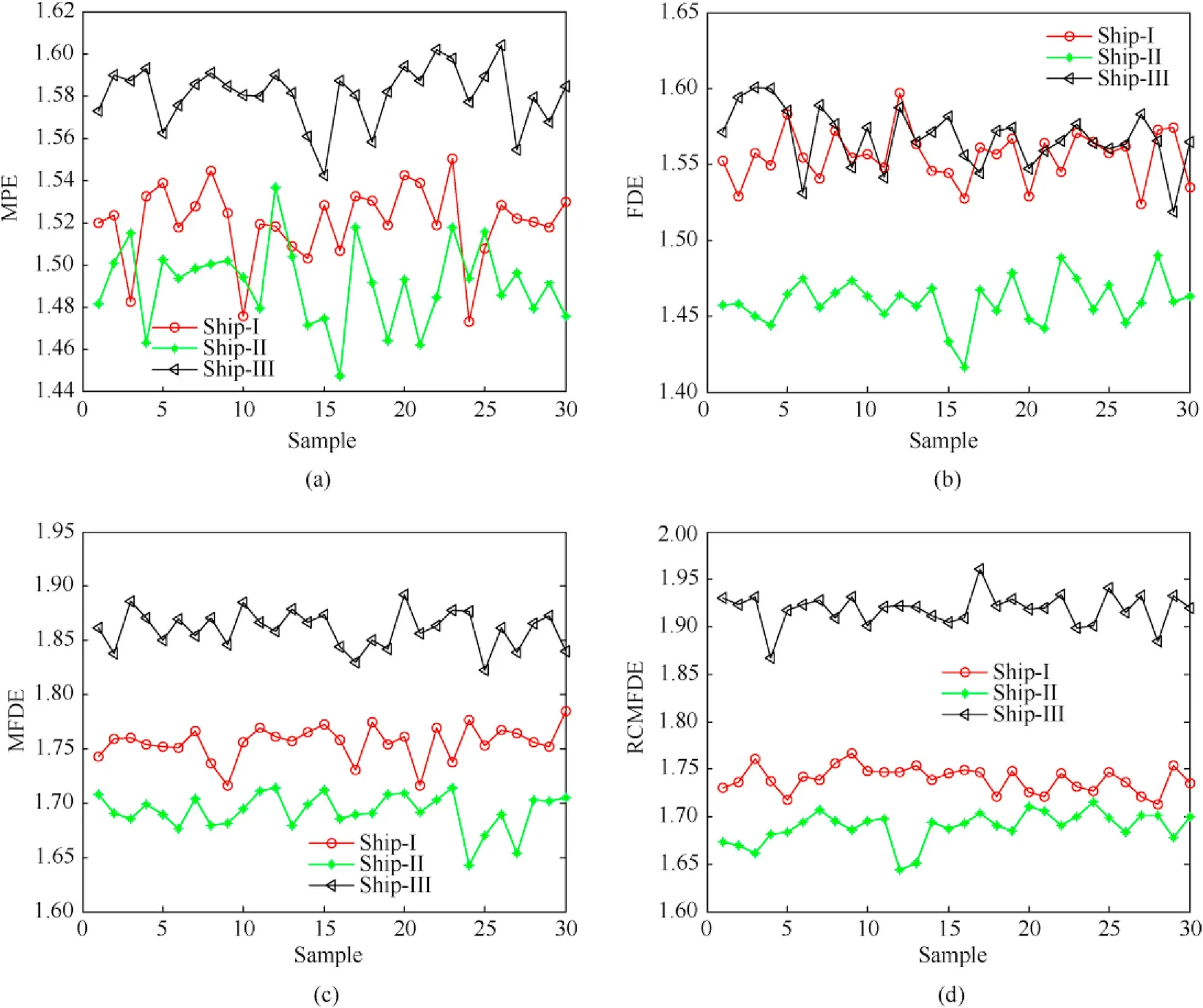
Fig. 7. The distribution of (a) MPE; (b) FDE; (c) MFDE; (d) RCMFDE.

Table 3 Characteristic IMF of ship-radiated noise.
4.3. Classification of ship-radiation noise
To further analyze the separability of the four methods, these characteristic parameters are sent to the SOM classifier.The first 10 data and last 20 data are regarded as the training samples and the testing samples, respectively. The classification results of shipradiated noise signals are shown in Table 4.
As shown in Table 4, the error rate of EMD-MEDR-RCMFDE feature extraction method is as large as 34.4%.
The CEEMDASN-MEDR-RCMFDE feature extraction method is 2.2%, and the Ship-III’s error rate is 0. The result shows that the proposed method is the most effective for ship-radiated noise feature extraction by comparing with those of EMD, EEMD, and CEEMDAN.
4.4. Application

Fig. 8. The feature extraction results of (a) EMD-MEDR-RCMFDE; (b) EEMD-MEDR-RCMFDE; (c) CEEMDAN-MEDR-RCMFDE; (d) CEEMDASN-MEDR-RCMFDE (The proposed method).

Table 4 The classification results of ship-radiated noise signals.
In order to verify the effectiveness and universality of the proposed method, in this paper, four different types of shipradiated noise recordings are used as targets for feature extraction. These signals include small ferries, small rescue hovercraft,small steam ships and engines. For convenience, these shipradiated noise signals are recorded as S1, S2, S3 and S4. The sampling frequency of each recording is 22.05 kHz and the duration is 11.34 s. In this section, 5000 points are selected as the sampling length,50 samples of each type of ship recording are selected,and each sample is normalized in turn.The time domain waveforms of S1, S2, S3 and S4 are shown in Fig. 9.
This section takes the radiated noise of the four types of ships S1,S2, S3 and S4 as the research object. The CEEMDASN-MEDRRCMFDE feature extraction method proposed in this paper is used to process these data, and verify the superiority and universality according to the classification effect. The distribution results of CEEMDASN-MEDR-RCMFDE are shown in Fig.10.
It can be seen from Fig. 10 that the ship-radiated noise CEEMDASN-MEDR-RCMFDE characteristic parameters make the four types of ship samples well differentiated,and the distribution results are relatively clear. The same type of ships has similar RCMFDE, and the RCMFDE of different types of ships has obvious differences. In order to verify the reliability of the above results,these characteristic parameters are sent to the SOM classifier. The first 25 data and last 25 data are regarded as the training samples and the testing samples, respectively. The classification results of ship-radiated noise are shown in Table 5.
It can be seen from Table 5 that the classification recognition ratio of the CEEMDASN-MEDR-RCMFDE feature extraction method is 98.5%.This characteristic parameter makes the four types of shipradiated noise effectively distinguished, the classification recognition rate is relatively high.The experimental results show that the feature extraction technology of ship-radiated noise proposed in this paper is effective and universal, which is more conducive to feature extraction and other subsequent processing of shipradiated noise.
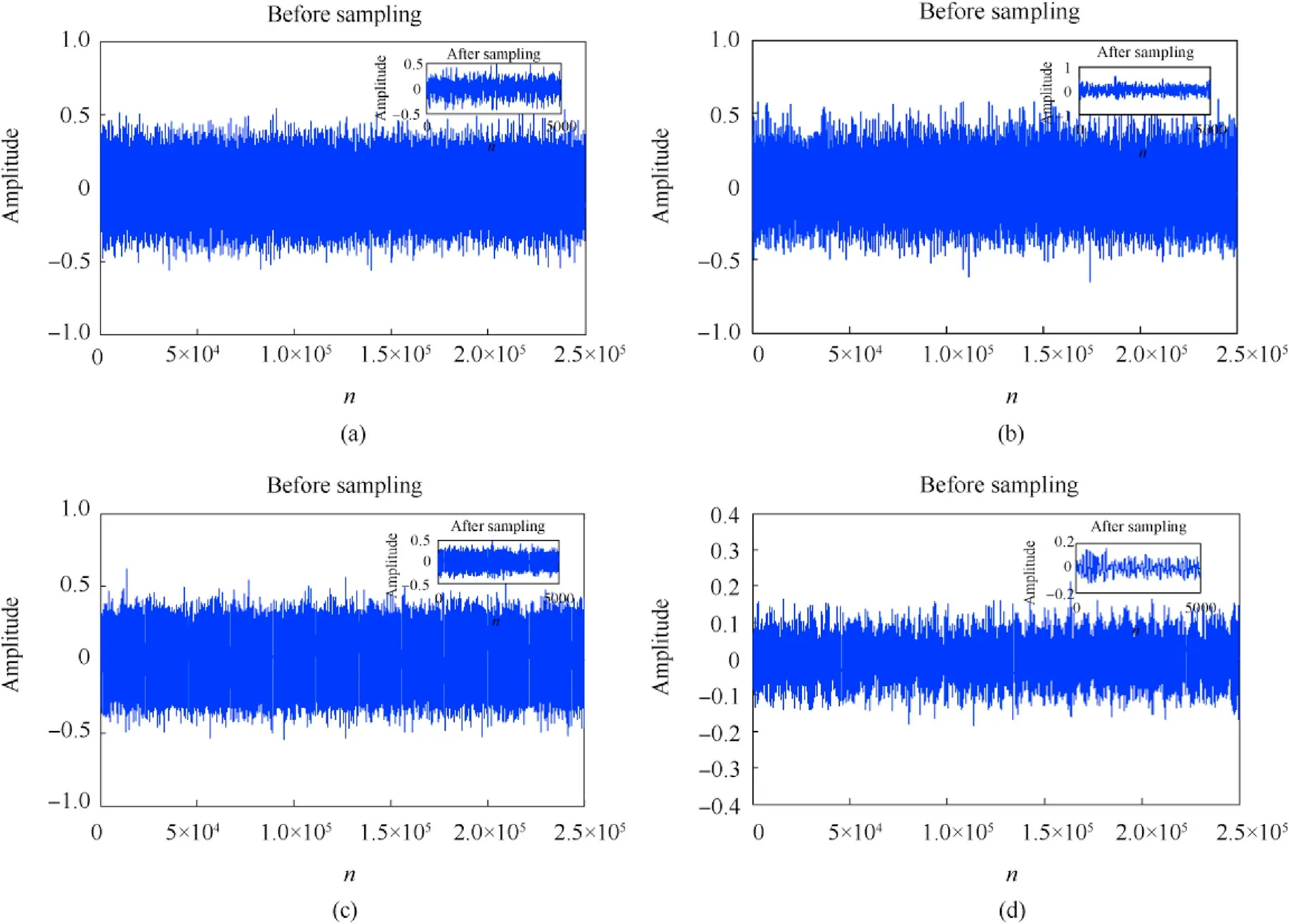
Fig. 9. The time domain waveforms of (a) S1; (b) S2; (c) S3; (d) S4.
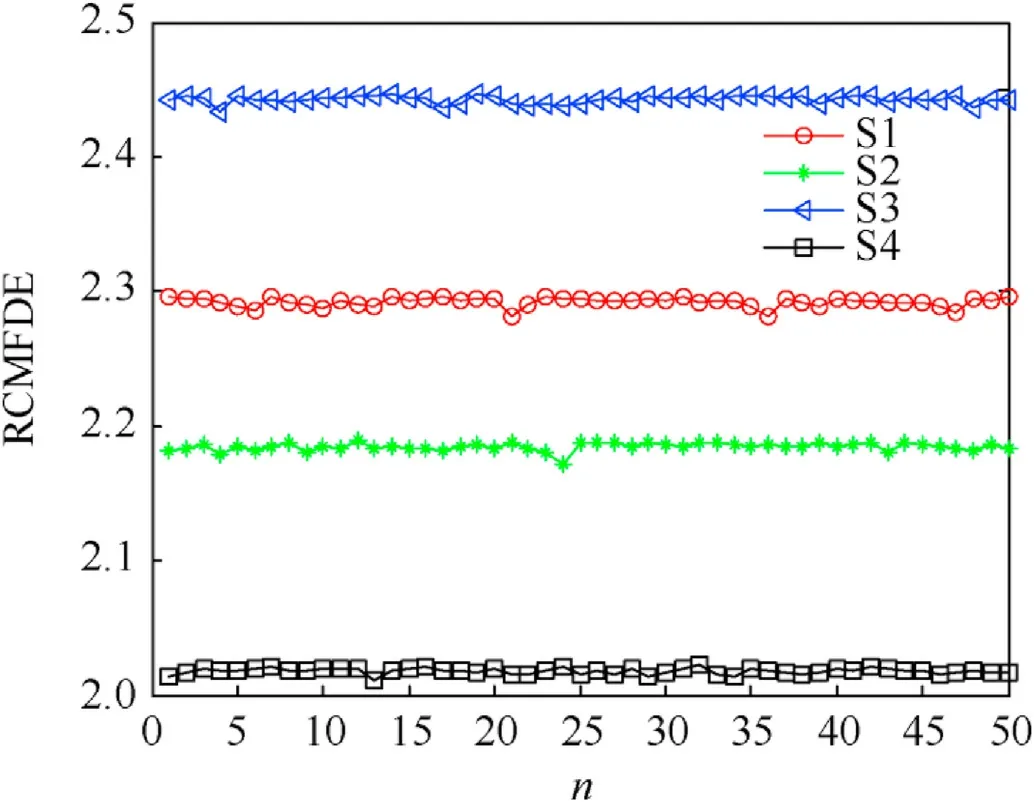
Fig.10. The distribution results of CEEMDASN-MEDR-RCMFDE.
5. Conclusion
To improve the feature extraction of ship-radiated noise in a complex ocean environment, a novel feature extraction method based on CEEMDASN and RCMFDE is proposed. The main conclusions of this paper are as follows:
(1) A new adaptive noise-assisted empirical mode decomposition algorithm CEEMDASN is proposed. The second type of mode mixing phenomenon, the larger residual error, and time-consuming problem are effectively resolved.The result shows that the decomposition effect of CEEMDASN is more clearly, which is beneficial to the processing of nonlinear,non-stationary signal.
(2) A new type of entropy RCMFDE is proposed.The problem of losing statistical information is effectively resolved,which is caused by the relationship between data that is not taken into account. The simulation result shows that RCMFDE is more accurate and stable than MPE, FDE, and MFDE.

Table 5 The classification results of ship-radiated noise signals.
(3) A novel feature extraction method of ship-radiated noise is proposed, which based on CEEMDASN, MEDR and RCMFDE.CEEMDASN-MEDR-RCMFDE, EMD-MEDR-RCMFDE, EEMDMEDR-RCMFDE, and CEEMDAN-MEDR-RCMFDE are applied to ship-radiated noise. The result shows that the proposed method has better separation effect and higher recognition rate, which can better solve the problem of the difficulty of the ship-radiated noise feature extraction in complex marine environment.
The authors declare that they have no known competing financial interests or personal relationships that could have appeared to influence the work reported in this paper.
This work was supported by the National Natural Science Foundation of China under Grant 51709228.
List of nomenclature
AEDRAverage energy distribution ratio
CEEMDComplementary ensemble empirical mode decomposition
CEEMDAN Complete ensemble empirical mode decomposition with adaptive noise
CEEMDASN Complete ensemble empirical mode decomposition with adaptive selective noise
CTConsuming time
DEDispersion entropy
EDREnergy distribution ratio
EEMDEnsemble empirical mode decomposition
EMDEmpirical mode decomposition
FDEFluctuation-based dispersion entropy
IMFIntrinsic mode functions
IOIndex of orthogonality
MEDRMinimum difference between EDR and AEDR
MPEMulti-scale permutation entropy
NCDFNormal cumulative distribution function
PEPermutation entropy
RCMFDE Refined composite multiscale fluctuation-based dispersion entropy
SampEn Sample entropy
SDStandard deviation
SISimilarity index
SOMSelf-organizing map
STFTShort-time Fourier transform
杂志排行
Defence Technology的其它文章
- Blast response of clay brick masonry unit walls unreinforced and reinforced with polyurea elastomer
- Adaptive robust feedback control of moving target tracking for all -Electrical tank with uncertainty
- Effects of phase change material (PCM)-based nanocomposite additives on thermal decomposition and burning characteristic of high energy propellants containing RDX
- A joint optimization algorithm for focused energy delivery in precision electronic warfare
- Mechanical properties of thermal aged HTPB composite solid propellant under confining pressure
- An optimized run-length based algorithm for sparse remote sensing image labeling
